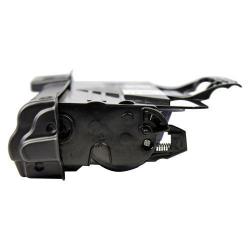Shopping for toner can be confusing, especially if you’re not familiar with the differences of yield amounts. Standard, jumbo, extended, starter, high yield toner cartridges….What’s it all mean? The differences are good to know because shopping wisely will save you money and help save the planet.
Before we get started, just a reminder in case you didn’t read my last blog about toner page yield — The page yields we’re going to look at are based on industry testing standards of 5% coverage, which equates to an average black and white page. This allows us an equal testing ground, so we’re not comparing apples to oranges.
Big brands like HP follow these standards when testing yield. So do lower priced but high quality brands such as our LINKYO. If the yield is higher based on 5% coverage, you can expect it to also be higher for less or more coverage.
That said, let’s get to the definitions and what this means cost-wise and ecology-wise.

Starter Cartridge: Have you ever purchased a new laser printer and wondered why the toner ran out sooner than expected? Some printer manufacturers include a starter cartridge so that it’s ready to use. However, this toner cartridge typically will yield less printed pages than a standard cartridge you buy separately. For this reason, it is called a starter reduced print yield cartridge.
For example, a standard toner cartridge might typically print 2,600 pages (with 5% coverage) but the new printer may come with a cartridge that only prints 1,500 pages (with the same coverage). Many consumers do not know this, hence there are lots of questions at printer manufacturer forums asking “Why did my printer run out of toner so quickly?”
Standard Yield Toner Cartridge: This one’s easier because just as the name implies, the yield is a standard amount. As mentioned above, for some cartridges the standard yield could be 2,600 pages with 5% coverage.
High Yield Toner Cartridge: As the name implies, the yield for this type of cartridge is higher than for a standard cartridge.
For example, the OEM (original equipment manufacturer) HP CE505X high yield black toner cartridge from HP for the LaserJet 05X series has a 6,500 page yield. The HP CE505A standard, compatible Black Toner Cartridge for the same LaserJet 05X series has a page yield of 2,300.
At this writing, the high yield costs $161.97, and the standard costs $89.87 at SuperMediaStore.com That’s $0.02 cents per page for the high yield compared to $0.04 cents per page for the standard.
Extended yield toner cartridge: This is the name that Micro Solutions Enterprises (MSE) and some of the other manufacturers use for toner cartridges that print more than the standard does.
Jumbo toner cartridge: This name, used by a few other manufacturers, is also for toner cartridges with yield’s higher than standard cartridges.
Whatever you call it – high yield, extended yield or jumbo, using toner cartridges that produce more pages than standard cartridges produce, not only saves money but is less harmful to the planet.
High Yield Toner Cartridges and the Environment
While somewhat more toner is used with high yield, fewer cartridges are needed because each can print more pages. Returning to our example above, printing with 6,500 yield cartridges compared to 2,300 yield cartridges, not only saves .02 cents per page, it uses 2.8 times less cartridges.
Green house gases are emitted during the manufacturing of cartridges.
Manufacturing one toner cartridge (the cartridge alone without the toner) emits approximately 4.8kg CO2 into our atmosphere. Using standard yield instead means approximately 13.44 kg CO2 is released.
Using fewer cartridges also means less cartridges are shipped, thus cutting back on fuel emissions. It also means less waste. More than 350 million cartridges are added to landfills on an annual basis. This plastic material doesn’t decompose well. A single cartridge takes up to 450 to 1,000 years to break down.
Whether using starter, standard or high yield toner cartridges, you can also make less of an imprint on the environment by printing memos and such in draft mode, using color only when needed, and recycling your toner cartridges and paper.

